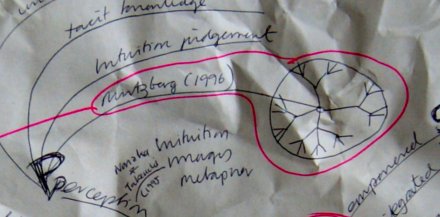Drawing on a business model, the development of a more organic structure that is less hierarchical, as envisaged by Mintzberg (1994), seems appropriate; it complements what authors such as John Seely Brown say about 'learning from the periphery' too. Adhocracy http://en.wikipedia.org/wiki/Adhocracy
Characteristics of an adhocracy (Waterman, 1990; Mintzberg, 1994; Travica, 1999):
· highly organic structure
· little formalization of behavior
· job specialization based on formal training
· a tendency to group the specialists in functional units for housekeeping purposes but to deploy them in small, market-based project teams to do their work
· a reliance on liaison devices to encourage mutual adjustment within and between these teams
· low standardization of procedures
· roles not clearly defined
· selective decentralization
· work organization rests on specialized teams
· power-shifts to specialized teams
· horizontal job specialization
· high cost of communication (dramatically reduced in the networked age)
· culture based on non-bureaucratic work
Handy’s Shamrock (1989)
The advantage of a flexible organisation is that it can react quickly to a change in its external environment.
Since the 1990s, firms have examined their value chain and tried to reduce their workforce to a multi-skilled core, which is concerned with the creation or delivery of a product or service. All other supporting, non-central functions are outsourced wherever possible to the periphery.
Charles Handy suggested, however, that organisations do not consist of just the Core and the Periphery, since the periphery can be subdivided.
He calls this a shamrock organisation:
The first leaf of the shamrock represents the multi-skilled core of professional technicians and managers, essential to the continuity of the business
The second leaf Handy calls the contractual fringe, because non central activities are contracted out to firms specialising in activities such as marketing, computing, communications and research
The third leaf consists of a flexible workforce made up of part-time, temporary and seasonal workers.
REFERENCE
Brown, JS
Handy, C (1989) The Age of Unreason
Mintzberg, H (1994), The Rise and Fall of Strategic Planning: Reconceiving the Roles for Planning, Plans, Planners, Free Press, pp. 458, ISBN 0-02-921605-2
Travica, B (1999) New Organizational Designs: Information Aspects, Ablex/Greenwood, ISBN 1-56750-403-5, Google Print, p.7
Waterman, R. H. (1990). Adhocracy: The power to change. The Larger agenda series. Knoxville, Tenn: Whittle Direct Books.
